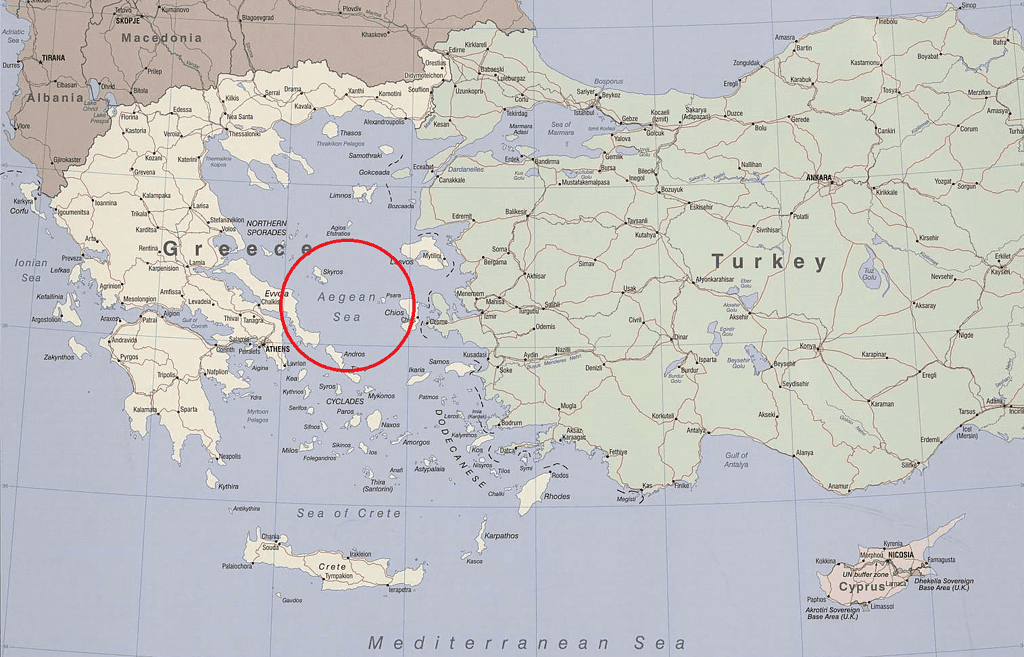It’s not hard to see why so many civilizations loved the Aegean sea, which sits between what is today Greece and Turkey. The weather’s great, the sea is turquoise and relatively quiet (compared to the oceans, at least), and the land is fertile on the dozens of islands you can inhabit and use. Across the millennia, these islands have been inhabited by several impactful cultures like the Minoans, but according to a new study, interest in these islands may even predate our species.

Hundreds of thousands of years ago, the first humans originated in Africa and it wasn’t too long before we started exploring and colonizing other continents. That’s happened several times across the millennia, but it may have happened even before our species’ time.
Imagining ancient hominids sailing across the Mediterranean sounds like a weird idea, because boats seem like a relatively advanced technology — something we’d be tempted to think that only we Homo sapiens can accomplish, but it may not be so crazy after all.
In 2018, a team of researchers claimed that Homo erectus, one of our species’ ancestors who first evolved 1.8 million years ago, sailed and reached islands as far away as the Indonesian island of Flores, and the Greek island of Crete. Now, a new study finds more indirect evidence that sailing may predate our species.
Pre-sapiens sailing
Previous research has found evidence that hominids, most likely Homo erectus visited islands in the Aegean sea. Researchers suspected that they moved from one place to the other simply by walking. It’s not that they could walk on water, but rather that during glaciation periods, when the global temperature was much lower than it is now, the sea level was lower (as more water was trapped as ice around the poles). So researchers assumed that these hominids simply walked on land bridges from what is now a group of islands.
But the new study challenges this assumption.
Researchers conducted a large-scale study of glaciations and how they affected sea level drops specifically in the Aegean sea. They looked at level markers at multiple sites in the area, finding that while the sea level had indeed dropped during previous ice ages, it was nowhere near low enough to create a land bridge. If they didn’t have land bridges, it follows that the only way to get from one island to the other would have been by sailing as early as 450,000 years ago.
This wouldn’t have been a particularly challenging type of sailing, like going from Europe to America, for instance. The islands are far closer to one another, and in many parts, you can even see them with the naked eye. It’s possible that these early sailors simply made rafts or even paddled on logs to get from one place to the other — but it’s a pretty remarkable achievement nonetheless.

Even a rudimentary sailing technology would have required a remarkable cognitive ability, and the researchers even suspect that sailing may have improved their cognitive power in time. Sailing requires a great deal of spatial awareness (even if the objective is close by), and doing it repeatedly could have been a useful mental exercise. The hominids are thought to have walked from Africa into the Middle East and then rafted across the Aegean Sea, presumably getting a bit better at navigating the seas as they practiced it.
“Therefore, the Aegean land/seascape motivated the archaic hominin to develop the necessary cognitive capabilities such as spatial awareness way-finding strategies and sea-craft building,” the authors write. “And hence, the Aegean Sea may be considered the cradle of sea-crossing in the Mediterranean world.”
This raises the question of why they went to such great lengths to explore different islands. There’s no clear answer — it could be plain and simple curiosity and a desire to explore, or it could be something more pragmatic, like the need to access new resources. For instance, one theory is that sea-wandering Homo erectus could have been hunting large game-like now-extinct dwarf elephants that lived in the region.
Still, while this study makes a compelling case for the seafaring abilities of hominids, it’s still all based on indirect evidence. Archaeologists haven’t found a smoking gun (like an actual boat used for sailing), and may never find one, so it’s not clear if this can ever be proven beyond the shadow of a doubt. But in the meantime, the case for seafaring hominids just got a lot stronger.
The study was published in the journal Quaternary International.









